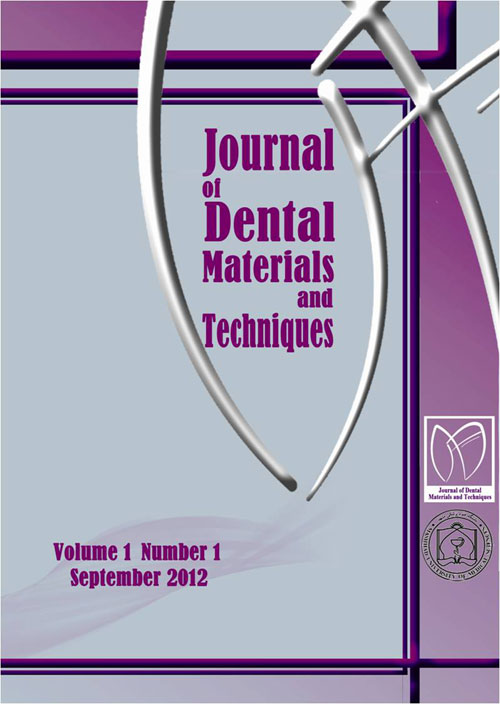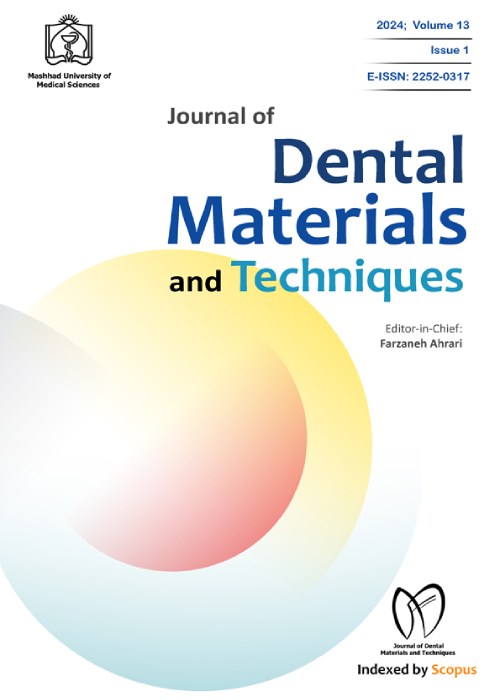فهرست مطالب

Journal of Dental Materials and Techniques
Volume:10 Issue: 3, Summer 2021
- تاریخ انتشار: 1400/08/05
- تعداد عناوین: 8
-
-
Pages 121-132Introduction
This paper aims to review the different characteristics of root canal irrigants including sodium hypochlorite (NaOCl), chlorhexidine (CHX), hydrogen peroxide (H2O2), iodine potassium iodide (IKI), antibiotic-based irrigants, photo-activated disinfection, electrochemically activated water, and QMix. The literature on root canal irrigation solutions in the context of endodontics up to June 2020 was reviewed using PubMed and MEDLINE. NaOCl was identified as the most likely effective irrigation solution that could be used for endodontics. Its antimicrobial activity is at least comparable or even greater than that of other common irrigants. Tetraclean was also proposed to be more effective than CHX against endodontic microorganisms. In addition, Hypoclean was suggested as the most potent and effective irrigant against Candida albicans. Similarly, IKI was introduced as a successful irrigant in killing Candida albicans and Enterococcus faecalis. MTAD is also known to be effective in smear layer removal as well as against the growth of Enterococcus faecalis. EDTA is also considered to have limited antimicrobial activity.
Keywords: Chlorhexidine, iodine compounds, MTAD, root canal irrigation -
Pages 133-141IntroductionThis study aimed to assess the cytotoxicity of Duraflur fluoride varnish as root canal sealer against L929 mouse fibroblasts in comparison with four commonly used conventional endodontic sealers in the first 48 hours of exposure.MethodsIn this in vitro, experimental study, L929 mouse fibroblasts were exposed to 1/1, ½, ¼ , and 1/8 concentrations of Duraflur fluoride varnish, AH Plus, Fill Canal, MTA Fillapex, and AH26 sealers. After 48 hours, the methyl thiazolyl tetrazolium (MTT) assay was performed to assess the cytotoxicity of sealers. Cell viability was determined as the percentage of viable cells compared with the control group. The results were analyzed using one-way ANOVA followed by the Tukey’s post hoc test for multiple comparisons..ResultsMTA Fillapex had the lowest and AH26 had the highest cytotoxicity (p <0.05). Fluoride varnish showed high cell viability in 1/8 concentration (91.09%). Its cytotoxicity was close to that of AH Plus with no significant difference (P=0.49) but it had higher cytotoxicity than Fill Canal and Fill Apex (p <0.05). Fluoride varnish in 1/1 and 1/8 concentrations showed significantly higher cell viability than AH26 (p <0.001).ConclusionFluoride varnish sealer has acceptable biocompatibility comparable to that of conventional sealers. It has lower cytotoxicity than AH26.Keywords: Cytotoxicity, Endodontic Sealers, fluoride varnish, Methyl Thiazolyl Tetrazolium Assay
-
Pages 142-147IntroductionThe aim of this study was to evaluate the length of styloid processes of edentulous and posterior dentate patients retrospectively using digital panoramic radiography.MethodsThis study was carried out in southwestern of eastern Anatolia region Turkish population. In this study, 100 styloid processes of each of edentulous and posterior dentate patients were measured on digital panoramic radiographs. Styloid process longer than 30 mm was evaluated as an elongated styloid process. Recording of data was performed based on gender, side and groups, Chi-square and Mann Whitney U test were conducted for statistical analysis.ResultsStyloid process length was not found to be statistically significant between edentulous (24.9±6.66) and posterior dentate (25.75±5.64) groups (p˃0.05). The frequencies of Elongated styloid processes were not statistically different between genders, side or groups (p˃0.05).ConclusionBeing edentulous was not an important factor for the length of the styloid process and the likelihood of symptoms that might develop.Keywords: styloid process, edentulous, eagle syndrome
-
Pages 148-156IntroductionMarginal seal is the critical factor for the success of any restoration. Accuracy of marginal seal of copings depends on alloy systems & manufacturing techniques. In every technique like laser sintered, conventional casting etcetera, significant marginal discrepancy takes place after porcelain firing. The aim of this study is to evaluate and compare the vertical marginal discrepancy of Ni-Cr and Co-Cr alloys before and after porcelain firing.MethodsCustom made stainless steel die model was prepared to simulate the dimensions of the mandibular molar with a round shoulder margin. Cast copings of two base metal alloys Ni-Cr alloy & Co-Cr alloy were prepared. Total 40 copings were made and divided into two groups, G1 (Ni-Cr alloy) & G2 (Co-Cr alloy). According to alloy type, 20 specimens were used for each group of the study. The vertical discrepancy was measured with an optical LASER microscope (Nikon, Japan) before and after application of porcelain on the copings. Wilcoxon signed ranked test and Mann Whitney U test were used for Statistical analysis.ResultsThe median vertical marginal discrepancy before and after porcelain firing for Ni-Cr alloy was 48.13 and 52.87 um respectively and for Co-Cr alloy was 95.33 and 100.04 um respectively. There is a highly significant difference (P < 0.001) in the median vertical marginal discrepancy between Co-Cr alloy copings & Ni-Cr alloy copings before & after porcelain firing.ConclusionsCo-Cr alloy PFM restorations have double vertical marginal discrepancy compared to Ni-Cr alloy restorations but both the values can be considered within clinical acceptability range of the marginal discrepancy.Keywords: Base metal alloy copings, firing cycles, Marginal seal
-
Pages 157-163IntroductionThe aim of the present study was to evaluate ordinary people`s perception about smile attractiveness in long face and short face subjects with linear and angular midline deviations.MethodsFrontal facial smiling images of two young Iranian females (one short face and one long face) were manipulated by Adobe Photoshop CS3 software. Four photos with different linear midline deviations to right (1mm, 2mm, 3mm and 4mm) and four photos with counter clockwise angular midline deviation (2˚, 6˚, 10˚, 14˚) were produced. Sixty Iranian individuals (30 males and 30 females) were asked to determine from which photo on, they found that the smile is unattractive.ResultsUnlike angular midline deviation, there was no statistically significant difference in the acceptability limitation for linear midline deviation between long face and short face subjects. The mean of unattractive limitation for angular midline deviation was 8.44˚ and 6.56˚ in long face and short face subjects, respectively. No statistically significant differences were found in ratings between male and female examiners.ConclusionAngular midline deviation is more acceptable in long face people. On the other hand, the attractiveness of the two facial types is similarly affected by linear midline deviationKeywords: facial height, Midline, Smile
-
Pages 164-172IntroductionThe aim was to evaluate the polymerization properties of bulk-fill composite resins in terms of the degree of conversion (%DC), Vickers hardness (HV). SonicFill (SF, Kerr, CA, USA), Tetric Evo Ceram Bulk-Fill (TECBF, Ivoclar Vivadent Schaan, Lichtenstein), and X-trafil (XTF, Voco GmbH, Cuxhaven, Germany) were investigated.MethodsThe samples prepared from composites (n = 10) were polymerized via three different curing modes (standard mode: 20 s, high-power mode: 12 s, extra power mode: 6 s) using a polywave LED. %DC was determined by FTIR-ATR-spectroscopy. HV was measured at the top and bottom of the specimens. Data were analyzed by two way ANOVA, and Bonferroni’s post-hoc respectively (α=0.05).ResultsExcept TECBF (%41.10 ± 3.1) in three different curing modes, all materials showed no significant inferior %DC. In all curing modes, the highest hardness ratio was found in XTF (0.84 ± 0.03 GPa), and the lowest hardness ratio was found in the TECBF (0.78 ± 0.02GPa). In the cases where the extra power mode of the Valo Led was applied, the lowest degree of conversion and hardness were also measured.ConclusionIt has been observed that the examined properties of some tested materials change with the curing time and power of the light and however, the results are dependent on the material.Extra power mode of the Valo Led negatively affected high viscosity bulk-fill composites in terms of their polymerization propertiesKeywords: Bulk-fill, resin composite, light curing, degree of conversion, vickers hardness
-
Pages 173-177Introduction
Non-surgical endodontic retreatment and surgical endodontic therapy may not be practical for the treatment of endodontic diseases. Intentional replantation is considered as a procedure of last resort when nonsurgical or surgical endodontics is contraindicated.
Case reportA 35 year- old female attended the endodontist office with pain and apical lesion in endodontically treated tooth ≠47. Access preparation for retreatment is a problem due to the posts and crown and surgical endodontic therapy was limited by anatomical features including nerve proximity and bone thickness. In addition, the patient could not afford to pay for non-surgical re-treatment or implant therapy
ConclusionThis report demonstrates intentional replantation as a treatment that can be considered when other options such as endodontic retreatment or apical surgery are impossible.
Keywords: Intentional replantation, endodontic treatment, Surgical approach -
Pages 178-184Introduction
One of the most challenging cases in implantology is severely atrophic alveolar ridges which do not have adequate bone for implant placement. One common treatment option for dealing with this challenge is LeFort I osteotomy with inlay bone graft which allows implant insertion and correction of the maxillomandibular relationship simultaneously. Although this method has a high success rate, it is somewhat invasive and has potential complications in some cases. In recent decades, implant surgeons have focused on less invasive and more predictable treatment options for bone augmentation and implant rehabilitation. Now a question comes into mind when there are not much discrepancies in maxillomandibular skeletal relationship and inter arch distance, do we really need LeFort I down-grafting and take its risks?
MethodsIn this study, we present a case who did not need any change in the skeletal relationship of the jaws and inter arch space based on examination and prosthetic consultation, so we implemented bilateral simultaneous sinus and nasal floor augmentation instead of LeFort 1 interpositional inlay bone graft.
ResultsSix months after the surgery, new radiography showed adequate height and width of augmented bones gained in and under sinuses and nose floor. So there is no limitation on choosing suitable implant lengths and diameters.
ConclusionThis study indicated successful augmentation of severely resorbed maxillary alveolar ridge with bilateral sinus and nose floor grafting technique instead of LeFort I interpositional bone graft in a case who didn’t have more discrepancies in skeletal and inter arch space.
Keywords: Bone augmentation, Sinus Lift, nasal floor, atrophic maxilla, Implant


